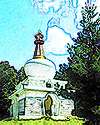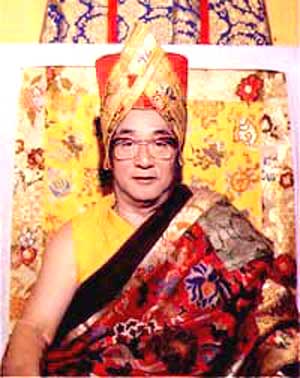Friday,
March 28, 2003 7:00 P.M.
Longlife Puja
for Takster Rinpoche (Thubten J. Norbu)
Suggested donation $15.00 ($12.00 seniors/students/TCC members)
Sunday,
March 30, 2003 7.00 P.M.
Teaching: "Four
Contemplations that Transform the Mind"
Suggested donation $15.00 ($12.00 seniors/students/TCC members)
In Tibetan
Buddhism, lamas teach "The Four Contemplations that Transform
the Mind" in order to introduce the need to follow the Buddha's
teaching. Through reflecting upon these teachings, a person is
disillusioned about the vanities and shortcomings of wandering
through life after life motivated by self-interest; perceives
the need for compasionate activity, and is led to training in
the spiritual disciplines of Buddhism.
The Four contemplations
are: (1) The Presciousness of a Human Birth, (2) Death and Impermanance,
(3) The Principles of Action and Causation (wholesome acts have
pleasurable results, unwholsome acts have painful results), and
(4) The Failings of Cyclic Existance (wandering through life
after life).
Venerable Jigdal
Dagchen Sakya Rinpoche
His Holiness
Jigdal Dagchen Sakya, head lama of the Sakya order of Tibetan
Buddhism, is a descendant of the powerful Tibetan Sakya lamas
who established relationships with the Mongol Khans in central
Asia in the 13 century. The relationships began with his forebearer,
Sakya Pandita, who lived 1182-1251 and who made it possible for
the Sakyas to rule Tibet for 100 years.
H.H.J.D. Sakya
was born into the Phuntshog branch of the Khon lineage in Sakya,
Tibet in 1929. He studied Buddhism with his father, His Holiness
Trichen Ngawang Thutop Wangchuk, the last Great Sakya Throne-holder
in Tibet, from whom he received teachings of the unbroken Knon
lineage transmission: the Sakya Vajrakilaya, Hevajra, the complete
Lamdre Tsogshe, "Path and Fruit" and other Sakya teachings.
Following the
passing of his father, H.H.J.D. Sakya travelled to East Tibet
to study in depth with two of this century's greatest masters,
non-sectarian Dzongsar Khyentse Jamyang Chokyi Lodro and Nyingma
master Dingo Khyentse Rabsel Dawa Rinpoch. From them, he received
further teachings, which are the non-sectarian Tibetan Buddhist
practices of the four main sects: Nyingma, Kagyu, Gelug, and
Sakya.
After the Chinese
Communist takeover of Tibet, H.H.J.D. Sakya, one of the two major
lineage holders of the Sakya tradition, was forced to leave his
homeland in 1959. He was invited to the United States by the
Rockefeller Foundation as a Tibetan scholar on the faculty of
the University of Washington in Seattle Washingotn, USA, where
he has resided since 1960.
In 1974, H.H.J.D.
Sakya and H.E. Dezhung Rinpoche founded Sakya Tegchen Choling
Center for the Study of Tibetan Buddhism.
In 1984, H.H.J.D.Sakya
purchased a First Sakya lineage in the West as well as a seat
of cultural and religious learning. Bernardo Bertolucci's 1993
film, "Little Buddha" featured Sakya Monastery during
remodeling.
Now that remodeling
is nearing completion, the Monastery is directing it's attention
to educational activities. To this end, in 1997, the Monastery
founded the Virupa Ecumenical Institute. Ongoing Institute programs
began in spring 1998.
H.H.J.D.Sakya
gives extensive empowerments and teachings ithroughout the United
states, Canada, Europe, Asia, and Taiwan. For more iformation
about Sakya Monastery and their varied programs, please go to
the website at http://www.sakya.org





